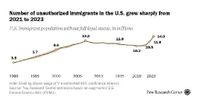For the first time in more than half a century, the United States is witnessing a decline in its immigrant population—a reversal that has sent shockwaves through communities, policymakers, and researchers alike. According to recent analyses by the Pew Research Center, the number of immigrants living in the U.S. dropped from a record 53.3 million in January 2025 to 51.9 million by June 2025. This 2.6% decrease, representing about 1.4 million fewer immigrants, marks the first sustained drop in the U.S. immigrant population since the 1960s.
California, long the nation’s gateway for newcomers, sits at the epicenter of this dramatic shift. Home to 11.3 million immigrants in 2023—nearly 28.4% of the national total—the Golden State is now ground zero for President Donald Trump’s renewed and aggressive deportation campaign. In his first 100 days back in office, Trump issued more than 100 executive actions on immigration, aiming to block new arrivals, strip temporary protections from those already in the country, and deport unauthorized immigrants at an unprecedented pace. His stated goal: one million deportations in his first year.
"There are a number of possible reasons from the natural ebb and flow of immigrants, but also policy, which has made it harder to cross the border and also increased enforcement in the U.S., all of which could be shaping the immigrant population and whether or not it grows or declines," Mark Hugo Lopez, director of race and ethnicity research at Pew Research Center, told CalMatters.
This new era comes on the heels of a historic surge. Between 2020 and 2025, more than 11 million immigrants arrived in the U.S., including over 3 million in 2023 alone—the largest annual total ever recorded, according to Pew’s analysis of government data. The unauthorized immigrant population, those living in the country without full legal status, reached a record high of 14 million in 2023 after two consecutive years of sharp growth. That group accounted for 27% of all U.S. immigrants and 4.1% of the total U.S. population.
Yet by mid-2025, the tide had shifted. Growth in the unauthorized population slowed considerably after mid-2024, as both the Biden and Trump administrations enacted new restrictions. The Biden administration, for its part, stopped accepting asylum applications at the border and paused parole programs in mid-2024, while Trump’s return brought a dramatic escalation in deportations and a rollback of protections for hundreds of thousands who had previously entered legally.
Pew’s data highlights the complexity of the “unauthorized immigrant” label. As of 2023, about 6 million unauthorized immigrants had some form of protection from deportation—up from 2.7 million in 2021. These included asylum applicants (2.6 million), parolees (700,000), victims of crime or violence (700,000), Temporary Protected Status (TPS) holders (650,000), and Deferred Action for Childhood Arrivals (DACA) enrollees (600,000). But such protections are temporary and can be revoked or allowed to expire, as the Trump administration did for about 500,000 parolees from Cuba, Haiti, Nicaragua, and Venezuela in 2025.
California’s large immigrant population has made it a focal point for both policy change and enforcement. The state’s 2.3 million unauthorized immigrants represent the largest such population in the country. Trump’s administration has targeted California’s protections and benefits for immigrants, including a high-profile challenge to a state law allowing undocumented immigrants to obtain driver’s licenses. In a recent incident, federal agents linked this policy to a fatal crash in Florida, though the driver involved had a federal work permit.
The enforcement push has been felt on the ground. Immigration agents in Los Angeles and elsewhere have detained both immigrants and U.S. citizens, sometimes using forceful tactics like throwing people to the ground or smashing car windows, according to CalMatters. Inside the country, Trump has leaned on military and surveillance technology to reinforce the border, while shifting Border Patrol agents to the interior to focus on detentions and removals.
Despite the crackdown, the majority of immigrants in the U.S. remain here legally. As of 2023, Pew reports that 75% of immigrants were either naturalized U.S. citizens (46%), lawful permanent residents (nearly 25%), or lawful temporary residents (4%). Unauthorized immigrants made up the remaining 27%, but even within this group, about 40%—roughly 6 million people—had some form of temporary protection from deportation, such as TPS or DACA.
The origins of America’s immigrants have also shifted. While Mexico remains the single largest source, accounting for 11% of new arrivals between 2021 and 2023, the share of unauthorized immigrants born outside Mexico grew sharply from 6.4 million in 2021 to 9.7 million in 2023. Countries like India, Venezuela, Cuba, Colombia, and others in South America and Europe have seen notable increases. For instance, the number of unauthorized immigrants from Venezuela soared from 195,000 in 2021 to 650,000 in 2023.
States beyond California are also experiencing the effects of these demographic changes. Texas, Florida, New York, New Jersey, and Illinois round out the top six states with the largest unauthorized immigrant populations. However, the distribution has become less concentrated: in 2023, the top six states were home to 56% of the nation’s unauthorized immigrants, down from 80% in 1990. Meanwhile, states like Florida and Texas saw the biggest recent growth, with Florida’s unauthorized population rising by 700,000 between 2021 and 2023.
Households across the country are deeply affected. In 2023, a record 7.5 million U.S. households included at least one unauthorized immigrant, representing 5.6% of all households nationwide. Most of these are “mixed status” families, meaning they contain both unauthorized immigrants and U.S.-born residents—often children. About 4.6 million U.S.-born children lived with at least one unauthorized immigrant parent in 2023, a figure that has rebounded since the pandemic and remains below the previous high of 4.9 million in 2016.
Unauthorized immigrants are also a vital part of the workforce. In 2023, they made up 5.6% of all U.S. workers, with particularly high concentrations in construction, agriculture, and service industries. In some detailed occupations, such as farming and construction, unauthorized immigrants represent up to 40% of workers.
Looking ahead, the full impact of recent policy changes is still unfolding. While preliminary data suggests the unauthorized immigrant population likely began to decline in 2025 due to increased deportations and reduced protections, Pew researchers caution that more complete data is needed to confirm these trends. What’s clear, however, is that after years of rapid growth, America’s immigrant population is entering a new era—one shaped by shifting policies, changing demographics, and the ongoing push-pull of enforcement and opportunity.
The story of immigration in the United States has always been one of change and adaptation. Now, as the numbers fall for the first time in decades, the nation faces fresh questions about its identity, its future, and the millions of lives caught in the balance.




